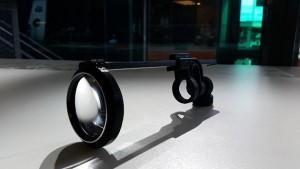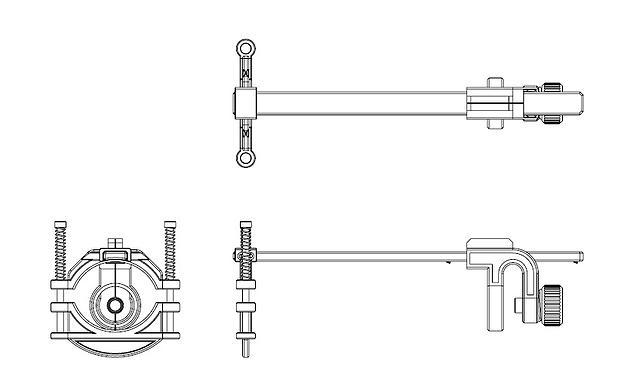It all started, as so many good things do, with a box full of fake eyeballs. A curious student doing a diploma in Ophthalmic Science in Auckland, New Zealand, was using the fake eyes not as we  might do, to scare our little sisters, but instead to practice performing retinal scans. Once he had gotten his fill of fakes, he turned to scanning anyone who would sit still long enough: his wife, his baby, his grandmother, and even a very surprised fish. He was able, after practice, to obtain reasonably clear results but we wouldn’t be writing about him if he had stopped there.
might do, to scare our little sisters, but instead to practice performing retinal scans. Once he had gotten his fill of fakes, he turned to scanning anyone who would sit still long enough: his wife, his baby, his grandmother, and even a very surprised fish. He was able, after practice, to obtain reasonably clear results but we wouldn’t be writing about him if he had stopped there.
He was capturing images of the retina using his smartphone. However, the process was unreliable because it requires taking a picture of an extremely still subject through a handheld examination lens while holding a smartphone with the other hand. One-handed photography is complicated enough without having to worry about the other two variables as well. Thus, he realized that he needed to do something to free up his hands and to stabilize the camera in order to create higher-quality images.
Not ready to give up, he began to draw out his ideas for creating a single unit adaptor that would hold both the lens and the smartphone. This way, he would have one hand free to, in his words, “secure the patient.” He quickly realized that although he understood the problem very well, he was not equipped to create its solution. He was, however, aware of 3D printing and prototyping as it has become a regular part of medical news at an ever increasing rate.
He started to assemble a team that could help him bring his idea from wishful thinking to actual production. He asked Daniel Dillen, a product designer and 3D printing specialist from Vivienda, and Hanna Eastvold-Edwins, a product and mechanical engineer from The Popcorn Collective, for help. Despite the semi-miraculous reputation of 3D printing, he did not have particularly high hopes that they would be able to design something successfully.
He soon found that he had grossly underestimated his team’s abilities. The first fully functional prototype, printed in PLA plastic, allowed for a 40 degree field of view of the retina. That may not mean much to the layperson, but it is comparable to that which can be obtained by a professional quality fundus camera. And to put that in perspective, a fundus machine can cost upwards of $16,000 and due to this innovation, was being replicated by a smartphone, a lens, and a handheld adaptor — all costing less than $50NZ.
The file for the 3D print will be uploaded and available freely to the public starting on May 8, 2015 because of this team’s commitment to enhanced availability of high-quality eye care treatment for everyone. The design is adaptable for a wide variety of smartphones and is open source allowing for individual contributions to its continued improvement. Currently, it is only available to receive one particular lens, but that is an area in which it will most likely receive the greatest benefit from the open source model.
There is also an app in the works, OphthDocs Eye App, to provide a range of vision tests, electronic medical record keeping, and image acquisition capabilities.
Let us know what you think about this 3D printed piece in the Smartphone Adaptor for Retainal Imaging forum thread over at 3DPB.com.
Subscribe to Our Email Newsletter
Stay up-to-date on all the latest news from the 3D printing industry and receive information and offers from third party vendors.
Print Services
Upload your 3D Models and get them printed quickly and efficiently.
You May Also Like
Metal Powder Supplier Elementum 3D Added to $46B Air Force Contract
Elementum 3D, a Colorado-based developer and supplier of metal powders used in additive manufacturing (AM), announced that the company has been added to the vendors list in the fourth on-ramp...
Ursa Major Lands $28.6M AFRL Deal for 3D Printed Draper Engine Flight Demo
The US Air Force Research Laboratory’s (AFRL’s) Rocket Propulsion Division at Edwards Air Force Base has awarded a $28.6 million contract to Ursa Major for follow-on work related to the...
3D Printing Financials: Rocket Lab’s Record-Breaking Year and Over 20 Launches Coming in 2025
Rocket Lab (Nasdaq: RKLB) closed 2024 with its best year yet. The company launched more rockets, signed more contracts, and expanded deeper into spacecraft and satellite production than ever before....
US Air Force Taps Beehive to Study 3D Printed Jet Engines
Propulsion 3D printing firm Beehive Industries secured a contract from the U.S. Air Force Life Cycle Management Center through SOSSEC. SOSSEC is a company that manages Other Transactions Authority (OTA)...


































